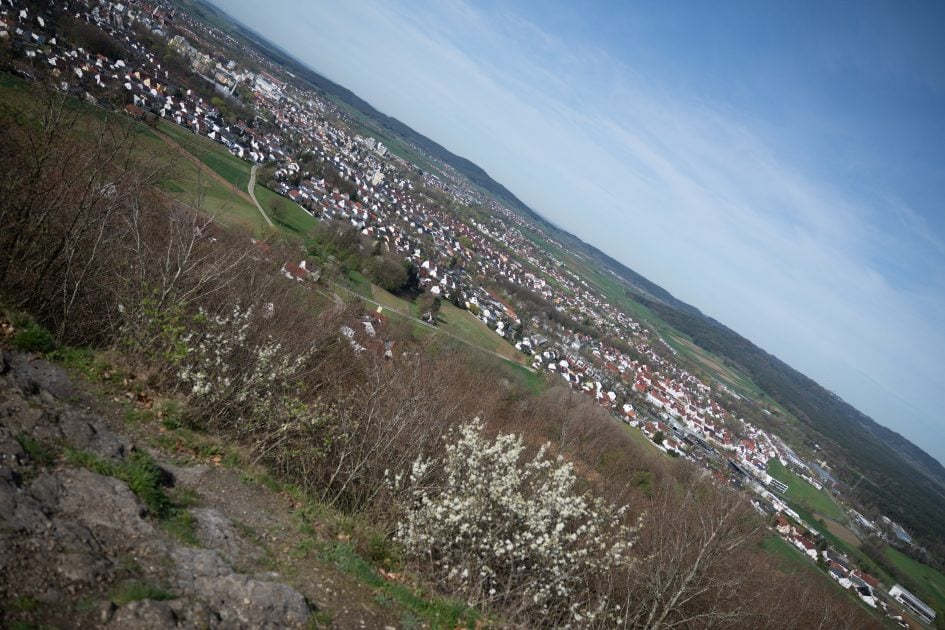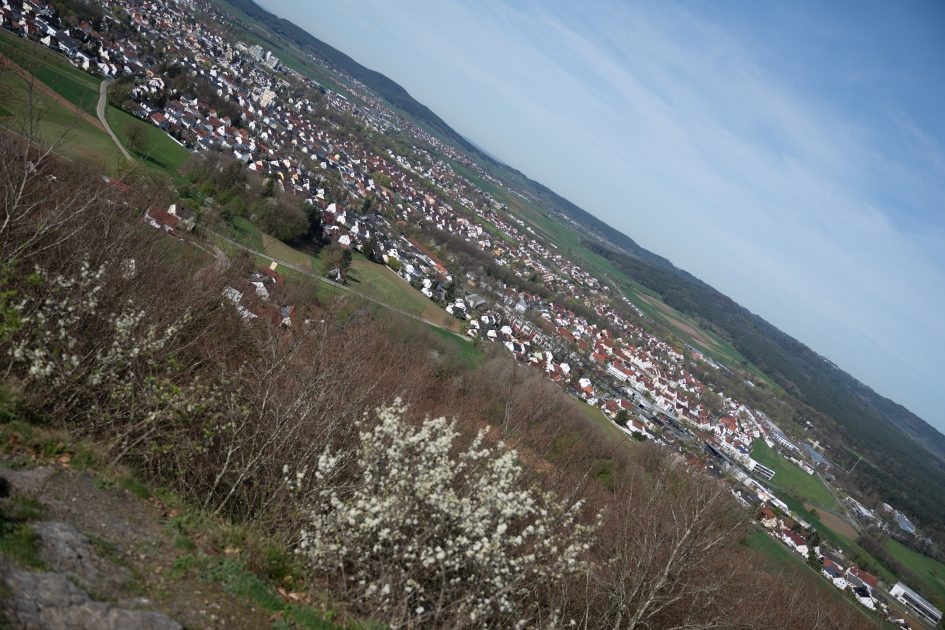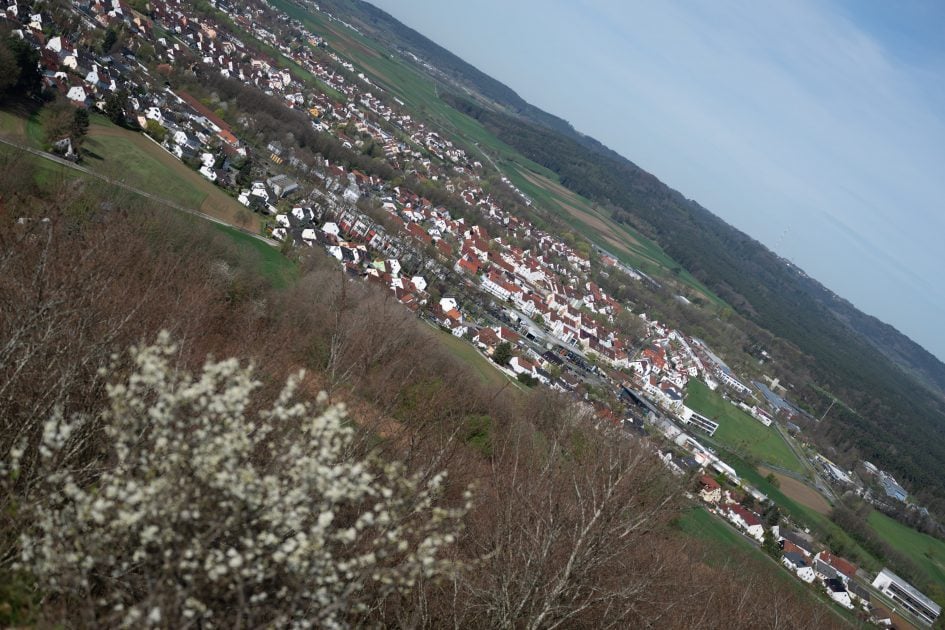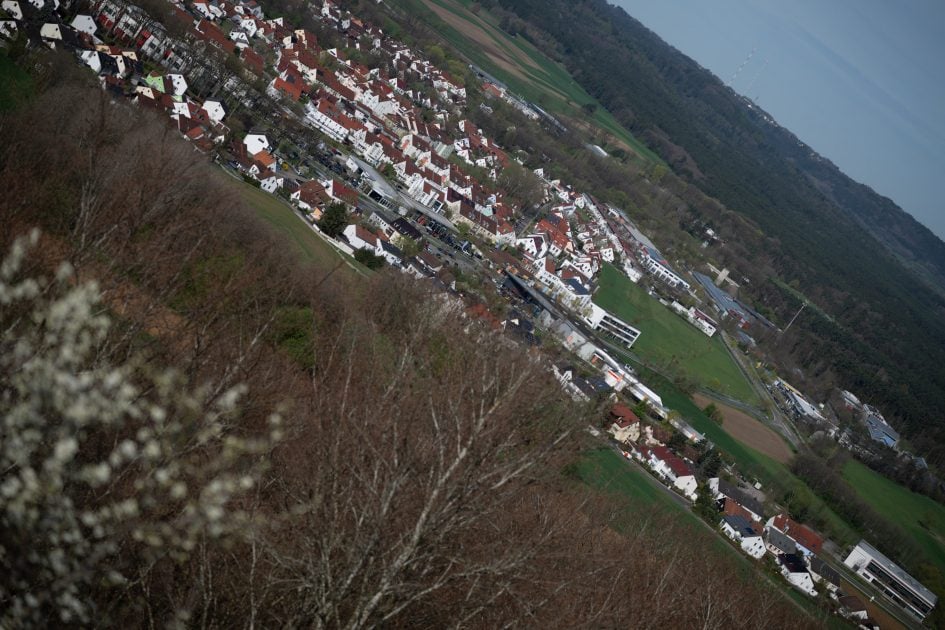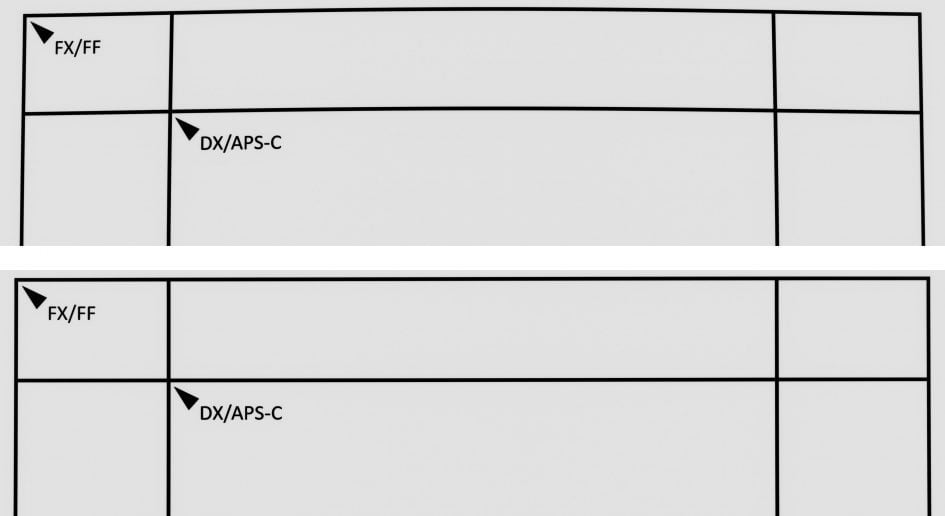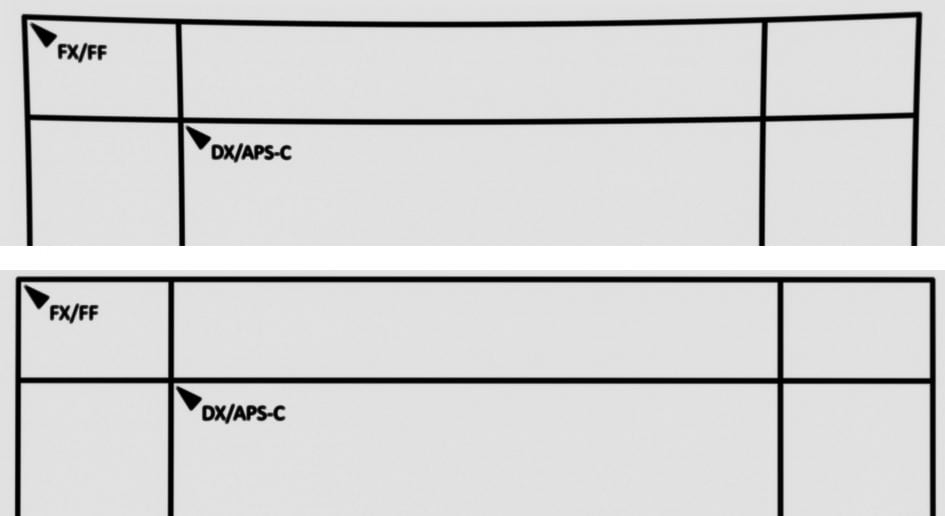Tamron 28-75mm f2.8 Nikon Z review
-
-
Written by Thomas
Quality
Testing with 180MP Pixel Shift Shooting
When Nikon introduced firmware V2.0 for their Z8 they included a clever way to increase the resolution of the camera to 180MP for free: Pixel shift shooting. What is it? The camera shoots a series of 16 NEF RAW images in quick succession shifting the image sensor a bit between each shot. When these individual images are merged in Nikon’s Studio NX software the resulting NEFX RAW file has 180MP resolution as well as less noise and aliasing artifacts. There’s also a 4- and 8-image mode which reduces noise and aliasing artifacts but stays at 45MP and a 32-image mode resulting in 180MP resolution with noise and aliasing artifacts even further reduced over the 16-image mode. The final image can then be processed further in Studio NX, Lightroom or Photoshop just like any “normal” RAW file. This also includes correction of distortions and vignetting through the lens profile.
What are the disadvantages of this method? Well, since the sequence of 16 shots takes almost 2 seconds to record any moving objects will be blurred or even completely unrecognizable in the merged image. See the following ghosts of a car:
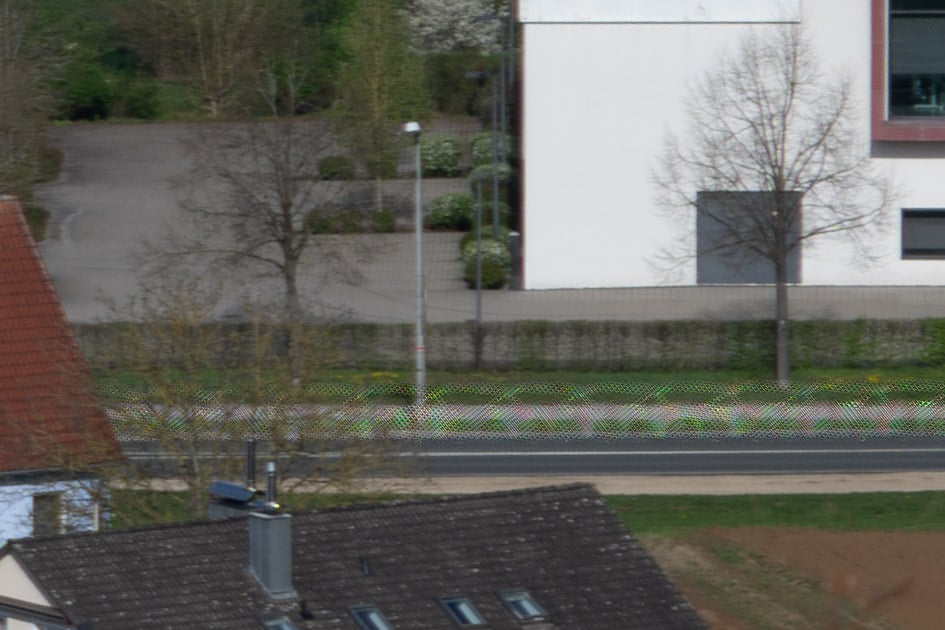
Above: Tamron 28-75mm f2.8 Di III G2 at 75mm, f5.6; 100% crop near FX-corner from 180MP original
This makes pixel shift shooting more suited for architecture, still-life, landscape (beware trees/flowers swaying in the wind!), macro photography – and of course shots of Siemens-star test charts! The other drawbacks of this method are the extra processing step (taking one minute to merge 16 images) plus the huge file size of the resulting final image: Around 900MB when the sequence was recorded as lossless compressed RAW. And with the 2x higher linear resolution diffraction becomes visible from f5.6 onwards instead of f8.0 in 45MP images.
To get a good impression of the advantages of using 180MP resolution for my test shots I grabbed my sharpest lens, the Voigtländer 50mm f2 APO-Lanthar, set it to f4.0 and shot the Siemens stars from the usual distance. At 100% magnification the test pattern from the 180MP image naturally appears double in size compared to my usual 100% crops from 45MP images. To make them comparable I enlarged the 45MP images 200% with automatic settings in Photoshop (see right side below):
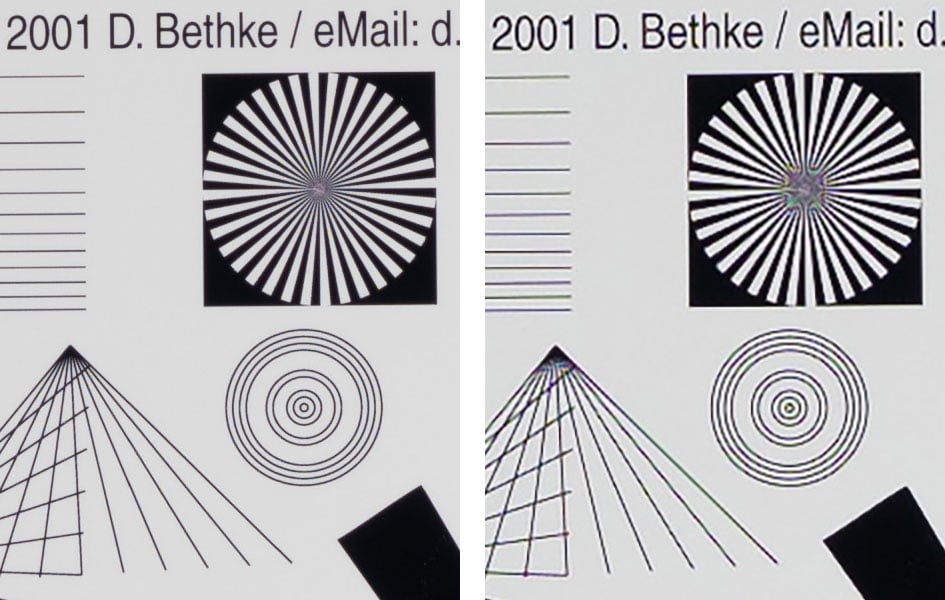
Above: Voigtländer 50mm f2 APO-Lanthar at f4.0, 100% crop from 180MP (left), 200% crop from 45MP (right)
Now, that’s a huge difference in image quality: The capability of the Voigtländer to resolve even the very fine structures in the center of the Siemens star can clearly be seen on the 180MP shot while at 45MP it is completely obstructed by the 50% lower resolution and aliasing artefacts. Btw: I used a radius of 1.0 for sharpening the 180MP image and 0.5 on the 45MP image.
Following is another comparison which shows that color moiré is also greatly reduced by pixel shift shooting:

Above: Voigtländer 50mm f2 APO-Lanthar at f4.0, 100% crop from 180MP (left), 200% crop from 45MP (right)
Because of these clear benefits I used pixel shift shooting in the following tests of sharpness and long distance performance. To make the crops from 180MP images comparable to my older reviews I present them at 50% magnification but you can click on them to access the 100% full resolution version like in the following example:

Above: Voigtländer 50mm f2 APO-Lanthar shot on a Nikon Z8 at f4.0, 50% crops from 180MP; click image for full resolution 100% crops
Now “pixel peeping” has reached a higher degree: “pixel shift peeping” 😉 With that let’s get back to the lens at hand: The Tamron 28-75mm f2.8 Di III G2.
Sharpness and contrast
Let’s have a look at the theoretical performance of the Tamron 28-75mm f2.8 Di III G2 and compare it to the Nikon Z 24-70mm f2.8 S and Nikon Z 28-75mm f2.8 (which uses the optical formula of the 1st generation Tamron 28-75mm f2.8 Di III):
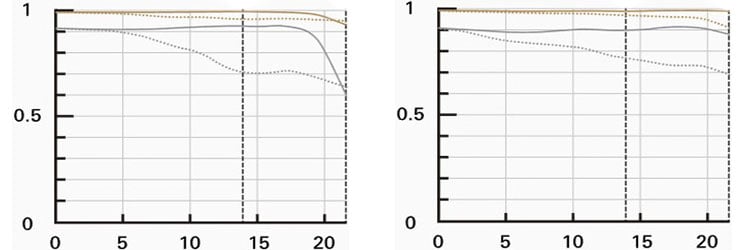
Above: Tamron 28-75mm f2.8 Di III G2 at 28mm f2.8 (left), 75mm f2.8 (right)
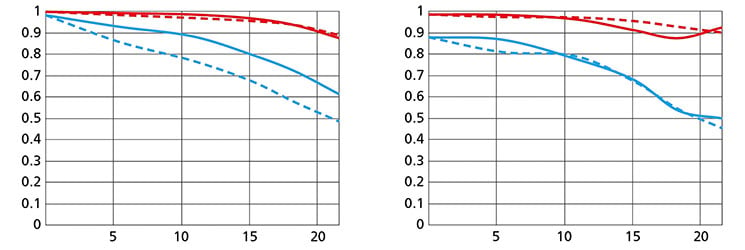
Above: Nikon Z 24-70mm f2.8 S at 24mm f2.8 (left), 70mm f2.8 (right)
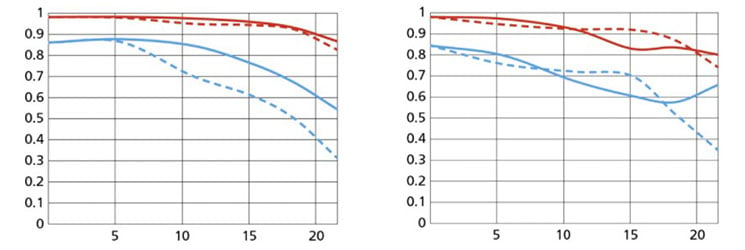
Above: Nikon Z 28-75mm f2.8 at 28mm f2.8 (left), 75mm f2.8 (right)
These MTF charts show the computed lens-performance of lenses wide open without influence of diffraction at 10 line-pairs/mm (yellow/red) and 30 lp/mm (gray/blue). Higher values are better (more contrast) and the closer the dotted and solid lines are together the less contrast dependents on the orientation of the test-pattern (less astigmatism). The x-axis displays the distance from the optical axis (=center of the sensor) in mm.
The Tamron 28-75mm f2.8 Di III G2 looks clearly better than the Nikon Z 28-75mm f2.8. And it might even beat the Nikon Z 24-70mm f2.8 S at the long end – at least on paper.
Let’s see how this theoretical performance translates into real life results in the sharpness test based on Siemens-stars shot on a Nikon Z8 set to 16 image Pixel shift shooting. The 16 individual images for each shot were merged in NX Studio 1.6.1 into a 180MP RAW file and further processed in Lightroom 13.2/CRAW 16.2 to Adobe Color profile with the lens profile compensating CA, distortions and vignetting. Noise-reduction was set to 0, sharpening to 50/1/36/10, with no extra tone, color, or saturation adjustment. White-balance was adjusted to a neutral white and I did some exposure compensation to make the brightness of all crops match. So you will not see light fall-off in the corners. I also focused separately for the center, the DX-corner, and FX-corner which eliminates any effect field-curvature might have.
First up is an overview of the wide-open performance at different focal lengths. You can jump to the detailed results at different apertures and comparisons with other lenses by clicking on the crops of the respective focal length.
Tamron 28-75mm f2.8 Di III G2; 50% crops from 180MP image near center, DX-corner, FX-corner
Above: 28mm, f2.8
Above: 35mm, f2.8
Above: 50mm, f2.8
Above: 75mm, f2.8
Tamron’s 28-75mm f2.8 Di III G2 is very sharp in the center throughout the zoom range – peaking at 50mm and only a tad softer at 75mm. The DX-corner is very good at 28mm, good at 35mm and 50mm, but suffers from astigmatism at 75mm. The FX-corner is surprisingly sharp at 28mm but becomes progressively softer towards 50mm where astigmatism takes its toll. At 75mm the FX-corner recovers quite a bit which makes it look better than the DX-corner at 75mm. Field curvature is strongest at 28mm but becomes less of an issue towards the long end.
Detailed results:
The following 50% crops show the Tamron 28-75mm f2.8 Di III G2 from wide open down to f11 compared to the Nikon Z 24-70mm f2.8 S at 28mm, 35mm, 50mm, and 75mm. I also included the Nikon Z 28-75mm f2.8 shot on a Nikon Z7 at 45MP resolution with crops presented at 100%. Or you skip the detail and fast-forward to the summary for this chapter.
Performance at 28mm:
Tamron 28-75mm f2.8 Di III G2 at 28mm compared; 50% crops from 180MP image
Above: Tamron 28-75mm f2.8 Di III G2 at 28mm, f2.8; click image for full resolution 100% crops
Above: Nikon Z 24-70mm f2.8 S at 28mm, f2.8; click image for full resolution 100% crops; also available at f4.0, f5.6, f8.0, f11 and at 24mm f2.8, f4.0, f5.6, f8.0, f11

Above: Nikon Z 28-75mm f2.8 on a Nikon Z7 (100% crops from 45MP) at 28mm, f2.8; also available at f4.0, f5.6, f8.0, f11
Above: Tamron 28-75mm f2.8 Di III G2 at 28mm, f4.0; click image for full resolution 100% crops
Above: Tamron 28-75mm f2.8 Di III G2 at 28mm, f5.6; click image for full resolution 100% crops; also available at f8.0, f11
Performance at 35mm:
Tamron 28-75mm f2.8 Di III G2 at 35mm compared; 50% crops from 180MP image
Above: Tamron 28-75mm f2.8 Di III G2 at 35mm, f2.8; click image for full resolution 100% crops
Above: Nikon Z 24-70mm f2.8 S at 35mm, f2.8; click image for full resolution 100% crops; also available at f4.0, f5.6, f8.0, f11

Above: Nikon Z 28-75mm f2.8 on a Nikon Z7 (100% crops from 45MP) at 35mm, f2.8; also available at f4.0, f5.6, f8.0, f11
Above: Tamron 28-75mm f2.8 Di III G2 at 35mm, f4.0; click image for full resolution 100% crops
Above: Tamron 28-75mm f2.8 Di III G2 at 35mm, f5.6; click image for full resolution 100% crops; also available at f8.0, f11
Performance at 50mm:
Tamron 28-75mm f2.8 Di III G2 at 50mm compared; 50% crops from 180MP image
Above: Tamron 28-75mm f2.8 Di III G2 at 50mm, f2.8; click image for full resolution 100% crops
Above: Nikon Z 24-70mm f2.8 S at 50mm, f2.8; click image for full resolution 100% crops; also available at f4.0, f5.6, f8.0, f11

Above: Nikon Z 28-75mm f2.8 on a Nikon Z7 (100% crops from 45MP) at 50mm, f2.8; also available at f4.0, f5.6, f8.0, f11
Above: Tamron 28-75mm f2.8 Di III G2 at 50mm, f4.0; click image for full resolution 100% crops
Above: Tamron 28-75mm f2.8 Di III G2 at 50mm, f5.6; click image for full resolution 100% crops; also available at f8.0, f11
Performance at 75mm:
Tamron 28-75mm f2.8 Di III G2 at 75mm compared; 50% crops from 180MP image
Above: Tamron 28-75mm f2.8 Di III G2 at 75mm, f2.8; click image for full resolution 100% crops
Above: Nikon Z 24-70mm f2.8 S at 70mm, f2.8; click image for full resolution 100% crops; also available at f4.0, f5.6, f8.0, f11
Above: Nikon Z 28-75mm f2.8 on a Nikon Z7 (100% crops from 45MP) at 75mm, f2.8; also available at f4.0, f5.6, f8.0, f11
Above: Tamron 28-75mm f2.8 Di III G2 at 75mm, f4.0; click image for full resolution 100% crops
Above: Tamron 28-75mm f2.8 Di III G2 at 75mm, f5.6; click image for full resolution 100% crops; also available at f8.0, f11
Summary:
The Tamron 28-75mm f2.8 Di III G2 delivers sharper FX-corners than the Nikon Z 28-75mm f2.8 or Nikon Z 24-70mm f2.8 S at every focal length. This is quite impressive – but the FX-corner certainly is not the most important area of an image.
At the center all three lenses deliver very sharp results with enough resolving power for 180MP pixel shift shooting. Looking closely the Z 24-70mm f2.8 S has a slight advantage at 28mm and 35mm, the Tamron is a tad sharper at 50mm, and at 75mm (resp. 70mm) I could see no discernibly difference between both lenses. The Nikon Z 28-75mm f2.8 looks also very good in the center but as it was shot at 45MP the aliasing artifacts create a bit of false extra contrast when compared to 50% crops from 180MP images.
In the DX-corner the Nikon Z 24-70mm f2.8 S delivers the best results over the zoom range while the Tamron can only match its performance at 28mm but at longer focal lengths even falls behind the Z 28-75mm f2.8.
Stopping the Tamron 28-75mm f2.8 Di III G2 down to f4.0 improves acuity outside the center leading to pretty uniform sharpness across the full-frame even when shooting at 180MP. Only the DX-corner at 75mm and the FX-corner at 50mm stay a bit soft.
Overall the Tamron 28-75mm f2.8 Di III G2 performs nicely in this test throughout the zoom range easily producing very satisfying results even at 180MP pixel shift shooting. Its only soft spots are the DX-corner at 75mm and the FX-corner at 50mm.
Performance at long distances
The Siemens-star test-targets are shot at a distance of 45x focal length (i.e. at around 3.4m for 75mm focal length). But performance of lenses also depends on the shooting distance. Therefore, I shot another series of a city around 1 km away on a Nikon Z8 set to 16 image pixel shift shooting. The 16 individual images for each shot were merged in NX Studio 1.6.1 into a 180MP RAW file and further processed in Lightroom 13.2/CRAW 16.2 to Adobe Color profile with the lens profile compensating CA, distortions and vignetting. Noise-reduction was set to 0, sharpening to 50/1/36/10, with no extra tone, color, or saturation adjustment. I used manual focus at the largest aperture and did not change focus for other apertures. All shots were made from a heavy tripod with image stabilization switched off at ISO 64. As usual I have selected the diagonal that provided the better corner results as the lens was a bit decentered.
The following images show the complete scene wide open plus 50% crops from near center, DX-corner, and FX-corner. You can access the large 180MP originals plus 100% crops, but the files are for personal evaluation only and cannot be used in another publication or website without permission.
Tamron 28-75mm f2.8 Di III G2 at 28mm
Above: Tamron 28-75mm f2.8 Di III G2 at 28mm, f2.8; click image for 4k version, here for large 180MP original; full resolution 100% crops available at f2.8, f4.0, f5.6, f8.0
Tamron 28-75mm f2.8 Di III G2 at 35mm
Above: Tamron 28-75mm f2.8 Di III G2 at 35mm, f2.8; click image for 4k version, here for large 180MP original; full resolution 100% crops available at f2.8, f4.0, f5.6, f8.0
Tamron 28-75mm f2.8 Di III G2 at 50mm
Above: Tamron 28-75mm f2.8 Di III G2 at 50mm, f2.8; click image for 4k version, here for large 180MP original; full resolution 100% crops available at f2.8, f4.0, f5.6, f8.0
Tamron 28-75mm f2.8 Di III G2 at 75mm
Above: Tamron 28-75mm f2.8 Di III G2 at 75mm, f2.8; click image for 4k version, here for large 180MP original; full resolution 100% crops available at f2.8, f4.0, f5.6, f8.0
Summary:
In this long-distance test the Tamron 28-75mm f2.8 Di III G2 produces a very sharp center over the complete zoom range. The DX-corner is also very sharp at 35mm, a tad softer at 28mm and 50mm, and quite soft at 75mm. The FX-corner is softest at 28mm probably due to field-curvature: Stop down to f5.6 or even f8.0 to get cleaner corners. At 35mm and 50mm the FX-corner is good before becoming a bit softer again at 75mm.
Vignetting and distortions
To make it easier to see light fall-off in the corners of a full-frame sensor I’ve arranged a series of three shots each with the Tamron 28-75mm f2.8 Di III G2. All images were developed to the same brightness in the center and are shown with vignette control Off (1st row) resp. Normal (2nd row):
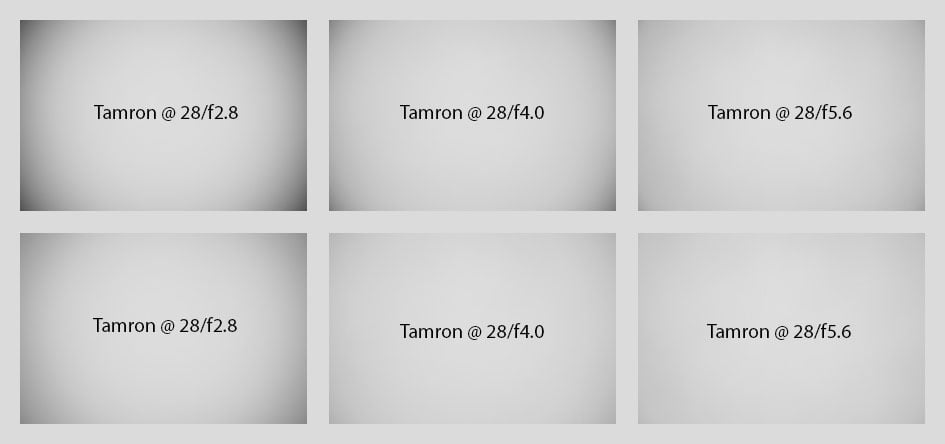
Above: Tamron 28-75mm f2.8 Di III G2 at 28mm focal length
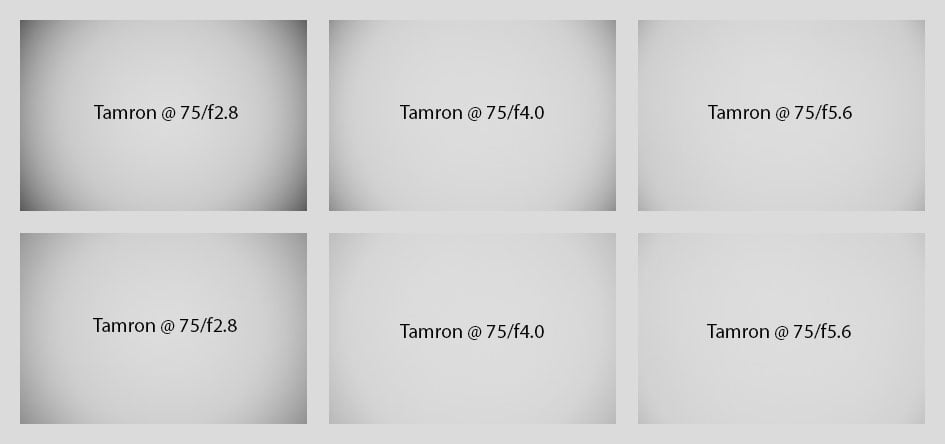
Above: Tamron 28-75mm f2.8 Di III G2 at 75mm focal length
Wide open vignetting is clearly visible even with the lens profile applied. At f2.8 vignette control lifts the extreme corners by 0.9 EV at 28mm resp. 0.8 EV at 75mm when set to Normal. From f4.0 onwards corrected vignetting is fairly low.
Adobe’s RAW converter does not automatically apply vignette or distortion control as it was set in camera: You need to activate the lens profile (e. g. in Lightroom) and than have sliders to control the strength of vignetting and distortion control between 0 and 200%. But there’s a snag: If you set vignetting or distortion control in camera to Off the slider to control the strength of vignetting or distortions in Lightroom or CRAW is disabled. So it’s better to leave both controls in camera activated if you shoot RAW. And if you shoot with an older model like the Z7 Adobe’s RAW converter automatically applies distortion correction regardless of what you chose in camera – but vignette control is applied as it was set in camera and you cannot alter these settings in post-processing. Still quite confusing, isn’t it?
Distortions show a slight mustachio at 28mm and evolve to a strong pin-cushion type at 75mm focal length:
Distortions: Tamron 28-75mm f2.8 Di III G2 at 28mm, as is (top) / with lens-profile (bottom)
Distortions: Tamron 28-75mm f2.8 Di III G2 at 75mm, as is (top) / with lens-profile (bottom)
LoCA, Coma, Bokeh, Close-up, etc.
Many of my usual tests don’t depend on the mount version of a lens. So, following is a summary of the findings from my review of the Tamron 28-75mm f2.8 Di III G2 for Sony E-mount:
- The lens shows a bit of loCA but no focus shift when stopped down and produces a bit of blooming and purple fringing around high-contrast edges in the focal plane plus some green outlining around background subjects.
- The lens is practically free of coma but it shows a touch of colored haloes around bright lights.
- Bokeh is free of onion-rings but shows some outlining and a very strong cat’s eye effect in the FX-corner. The transition zone is free of color artifacts and double contours are relatively weak.
- Close-up performance: At 28mm the lens is pretty sharp in the center at f2.8 already. But the area outside the center looks mushy even stopped down to f11. Using the lens at 75mm focal length produces much better results outside the center: F5.6 now looks at least usable – especially when you put your subject in the DX image-circle.
- The lens produces some ghosting artifacts but they are not very bright. Veiling glare is well suppressed.
- Sunstars are very weak at f5.6 but develop nicely when the lens is stopped down to f8.0 or better yet f11.
For more details head over to page 2 of my Tamron 28-75mm f2.8 Di III G2 review for Sony E-mount.
Next check out my sample images!
Check prices on the Tamron 28-75mm f2.8 for Nikon Z at B&H, Adorama, WEX UK or Calumet.de. Alternatively get yourself a copy of my In Camera book, an official Cameralabs T-shirt or mug, or treat me to a coffee! Thanks!
















